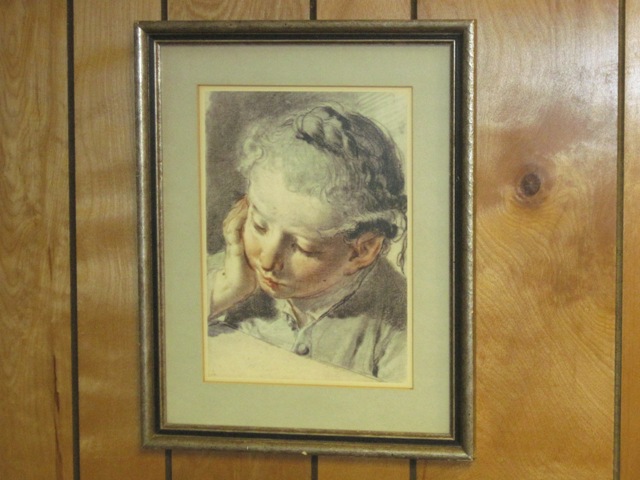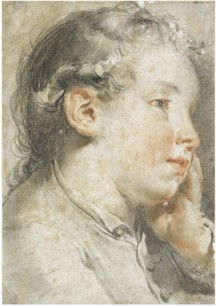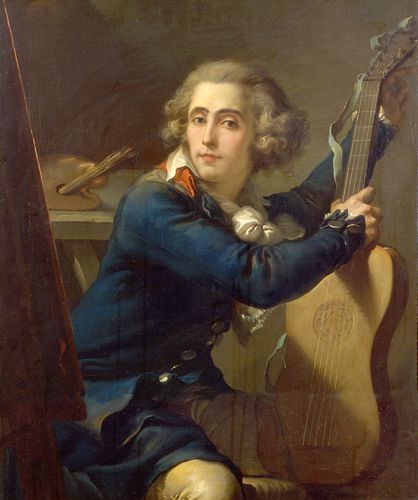Scene: Maitrakanyaka rides a horse to go hunting
Artist: Unknown
Date: Recent replica of an A.D. 8th Century stone temple carving
Size: 7.5 inches high and 23 inches long, without frame. I believe the original is three or four times this size.
Materials: originally Cambodian sandstone
Origin: Buddhist temple carving from Borobudur, a Mahayana Buddhist Temple in Central Java, Indonesia
Location of panel 114: Borobudur Temple, first gallery, lower wall series, East wall.
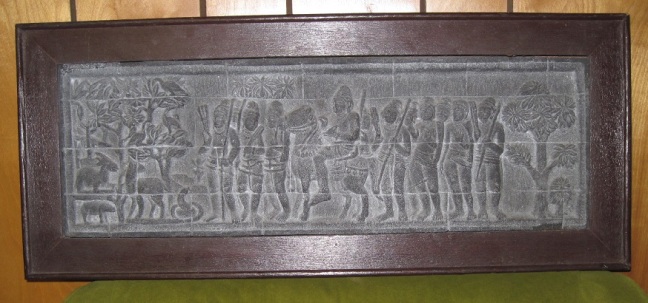
Carved in stone, the Buddhist traditions about Maitrakanyaka are shown in fifteen panels, 106 to 120. This one is Panel 114. [Impatient readers may skip to the final paragraph now.]
The label on the back of this piece identifies the rider as Maitrakanyaka, but researchers claim Panels 113-120 are, “not identified.” [1.]
The story of Maitrakanyaka begins with his father Maitra’s friends predicting the only way the child will survive is with a feminine name, literally, “daughter of Maitra,” so he will not die at sea. The father, a merchant, dies on an ocean voyage. After Maitrakanyaka grows up, his mother doesn’t want to lose her son, so she says at first his father was a shopkeeper, then a perfume merchant and a goldsmith. In each of these trades, he is very successful, and donates four large gifts to charity, in the amounts of 4, 8, 16 and 32 units of money. [Panel 106.]
To eliminate the competition, the other tradesmen inform him that to really follow his father’s footsteps, he must become a traveling merchant. His mother begs him to stay, grasping his feet. In anger, Maitrakanyaka kicks his mother’s head and leaves. [Panel 107.]
His voyage is cut short, when a sea monster wrecks his ship. (An alternate version says his companions blame him for no wind and throw him overboard.) [Panel 108.] Maitrakanyaka is washed ashore and meets four heavenly nymphs. He spends years enjoying their pleasure, and then succumbing to wanderlust. [Panels 109-111.] This happens four times, as he meets 4, 8, 16 and then 32 nymphs.
One day he wanders into an iron town and meets a tall man tortured with a flaming iron wheel on his head. [Panel 112.]
“Who are you?” asks Maitrakanyaka.
“A man who has mistreated his mother,” comes the answer.
Suddenly a voice is heard, “Those who are bound, are free, and those who are free are now bound.” The iron wheel leaped onto Maitrakanyaka’s head.
“How long is my punishment?” he asks. The answer: 66,000 years.
“Who will be punished after me?”
“One who has committed the same sin as yourself, ” says the man.
In pain but with compassion, Maitrakanyaka declares, “I am willing to wear this wheel forever on my head for the sake of my fellow creatures. May there never come another who has committed such sin.”
The wheel immediately lifts from his head and floats above him. At this moment the Bodhisattva Maitrakanyaka dies and is born again into heaven.
In Buddhism, a Bodhisattva like Maitrakanyaka is a person who seeks awakening and enlightenment with compassion for all beings. It is someone on the way to Buddhahood. I am probably not very accurate in these descriptions of someone else’s religion, but I hope you get a taste of it.
These stories in these panels are from the Divyāvadāna (divine tales), and are a kind of literature called avadana (former lives of virtue). The Borobudur Temple has thousands of bas-relief panels illustrating these legends.
In 1917 A. Foucher [2.] wrote about the temple sculptures: “While their chisels could only moderately carve the fine Cambodian sandstone into rather shallow pictures, the artists of Java, not disheartened by the coarse grain of the volcanic stone furnished by their island, have drawn from it veritable high-reliefs of an astounding depth. Their figures, in spite of the effeminate softness of their lines, are rightly celebrated for the justness of their proportions, the naturalness of their movements and the diversity of their postures. Above all, they exhibit a knowledge of foreshortening…” [3.]
If you read his essay describing the panels, you’ll encounter questing princes, genii, a magic ring, kings, jewels, monks and nuns. Foucher also suspects that the artists included extra scenes to fill wall space.
“Not only are the characteristic episodes thus drowned in a dull, monotonous flood of pictures without movement, but even in each picture the principal motif is often submerged under a veritable debauch of accessories and details. The only excuse here for the artists is to be found in the form of the frame, which is at least three times as wide as it is high. Consequently there is no great personage whose cortege is not spread out to form a wallcovering, sometimes over several rows….
“That is not all: the sculptors have made it, as it were, a point of honour not to leave vacant any part of the surface at their disposal….they go so far as to fill the space beneath the seats with [various items and]….animals of all kinds, cleverly sketched, indeed from life, with the single exception of the horses, which are mediocre.” [3.]
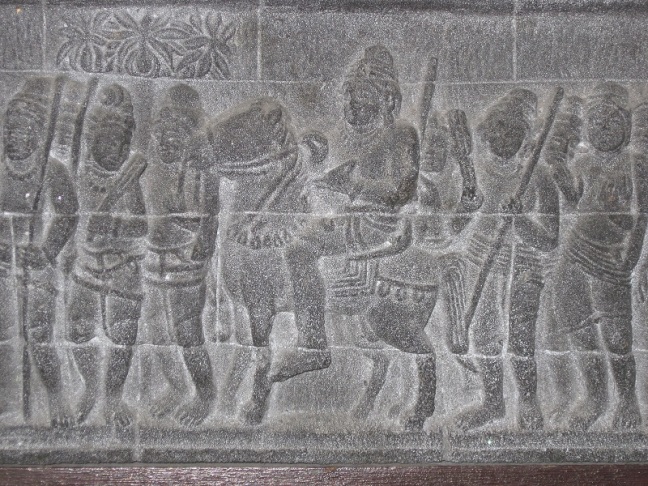
The artists are able to portray types of characters in the stories, but not individual likenesses. In other words, Foucher thinks they all look the same.
Is it weird for me to be quoting an European scholar while listening to “Indiana Jones and the Temple of Doom” music? Well, I hope I’m not too blinded by my Western ethos.
This panel shows Maitrakanyaka hunting while riding a horse. A group of guards with swords and arrows escort him. He is carved on the temple wall to illustrate a virtuous life to the faithful. If you visit the thousand-year-old Borobudur Buddhist Temple in Java, you will see that the lower level narrative pictures like this give rise to more iconic figures on the higher levels.
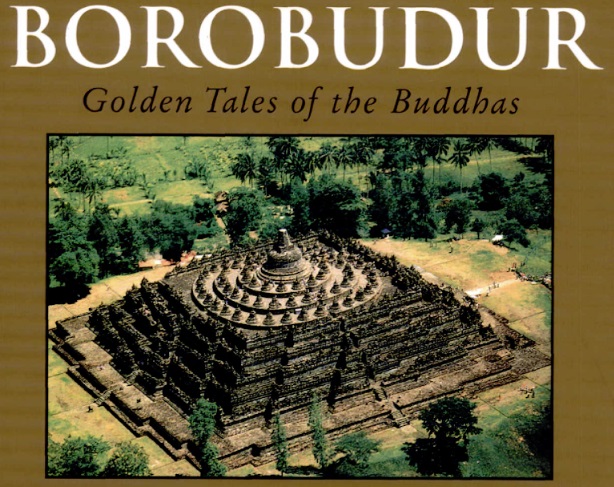
Sources:
- Borobudur: Golden Tales of the Buddhas, By John Miksic, Tuttle Publishing 1990, 2017 https://books.google.com/books?id=jwzQAgAAQBAJ&printsec=frontcover&source=gbs_ge_summary_r&cad=0#v=onepage&q&f=false
- Alfred Charles Auguste Foucher (1865–1952) was a French scholar who identified the Buddha image as having Greek or Roman origins. Wikipedia
- Buddhist Art in Java, 5. Maitrakanyaka’s Story, 1917 public domain text by A. Foucher, translated by L.A. Thomas and F.W. Thomas as part of ‘The Beginnings of Buddhist Art,’ re-edited with photographs by Anandajoti Bhikkhu in 2013.

